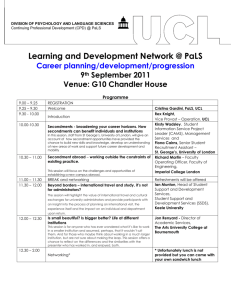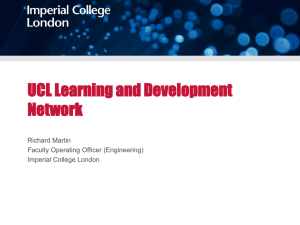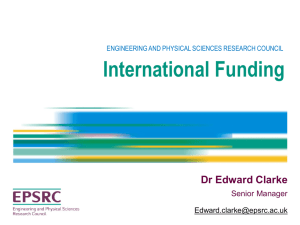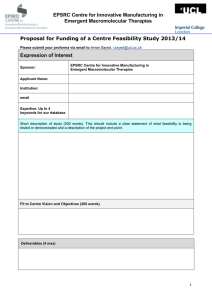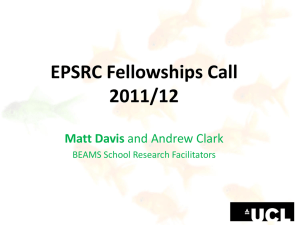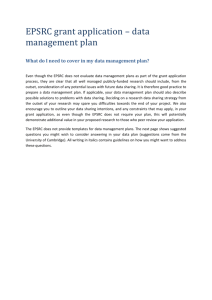KT Secondments (KTS) awards
advertisement
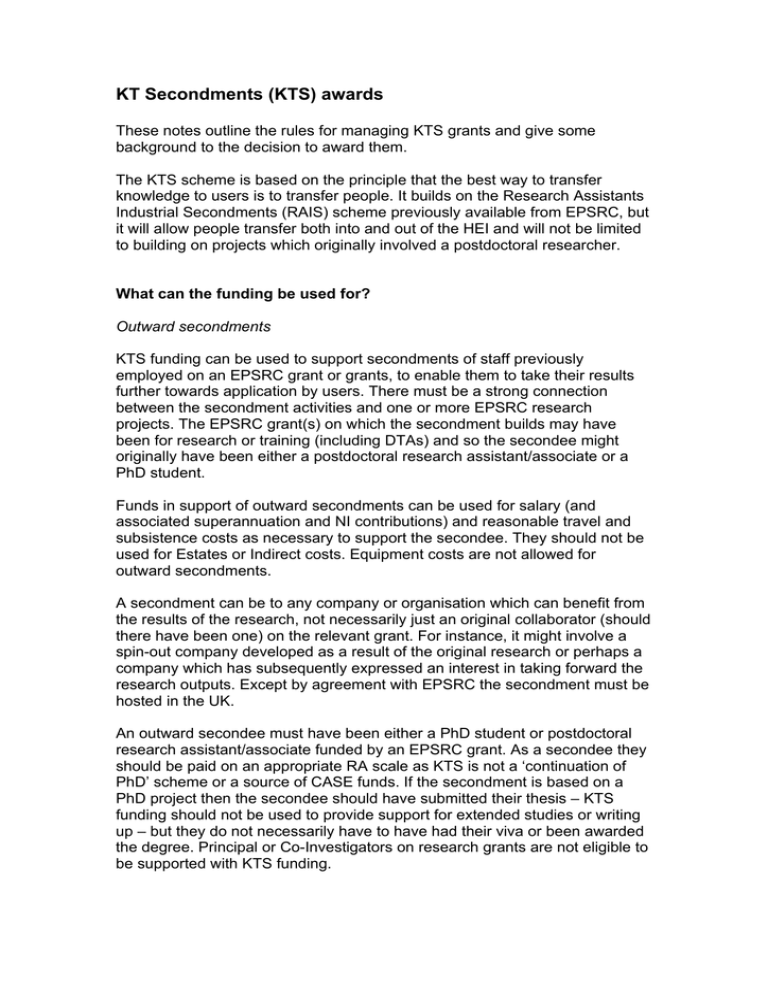
KT Secondments (KTS) awards These notes outline the rules for managing KTS grants and give some background to the decision to award them. The KTS scheme is based on the principle that the best way to transfer knowledge to users is to transfer people. It builds on the Research Assistants Industrial Secondments (RAIS) scheme previously available from EPSRC, but it will allow people transfer both into and out of the HEI and will not be limited to building on projects which originally involved a postdoctoral researcher. What can the funding be used for? Outward secondments KTS funding can be used to support secondments of staff previously employed on an EPSRC grant or grants, to enable them to take their results further towards application by users. There must be a strong connection between the secondment activities and one or more EPSRC research projects. The EPSRC grant(s) on which the secondment builds may have been for research or training (including DTAs) and so the secondee might originally have been either a postdoctoral research assistant/associate or a PhD student. Funds in support of outward secondments can be used for salary (and associated superannuation and NI contributions) and reasonable travel and subsistence costs as necessary to support the secondee. They should not be used for Estates or Indirect costs. Equipment costs are not allowed for outward secondments. A secondment can be to any company or organisation which can benefit from the results of the research, not necessarily just an original collaborator (should there have been one) on the relevant grant. For instance, it might involve a spin-out company developed as a result of the original research or perhaps a company which has subsequently expressed an interest in taking forward the research outputs. Except by agreement with EPSRC the secondment must be hosted in the UK. An outward secondee must have been either a PhD student or postdoctoral research assistant/associate funded by an EPSRC grant. As a secondee they should be paid on an appropriate RA scale as KTS is not a ‘continuation of PhD’ scheme or a source of CASE funds. If the secondment is based on a PhD project then the secondee should have submitted their thesis – KTS funding should not be used to provide support for extended studies or writing up – but they do not necessarily have to have had their viva or been awarded the degree. Principal or Co-Investigators on research grants are not eligible to be supported with KTS funding. It is not essential that a secondee moves directly from an EPSRC-funded post to their secondment. There is no particular time lag after which a secondment for an EPSRC-funded researcher is forbidden, although the requirement for there to be a strong connection between the secondment project and EPSRC funding must be remembered. Inward secondments KTS funds may also be used in support of inward secondments. An inward secondment must comprise a specific research project in your HEI, carried out by someone employed by a user organisation and building on knowledge generated with EPSRC funding. It should not be used for general provision of user advice or industrial guidance on identifying and exploiting the results of research. There must be a strong connection between the secondment activities and one or more EPSRC research projects. KTS funds for inward secondments may be used for Indirect and Estates costs and reasonable research consumables. They cannot be used to purchase major items of equipment (although reasonable consumables necessary to support a research project are allowed) or to pay the secondee’s salary. Are there any other rules? You are free to decide the balance of inward and outward secondments to be supported, and any mix of these two is acceptable. The KTS grant should not be used to support general administration of its own funds. The same researcher may go on more than one secondment using this funding. Sequential (but not necessarily continuous) outward secondments to different organisations are acceptable. Engagement with a user organisation through inward secondments may similarly happen over an extended period and involve more than one individual. Secondments can be for whatever duration you feel is most appropriate to the requirements of a particular collaboration. Anything from a few weeks to a year would be reasonable and it is up to you to judge this. Secondments may be full- or part-time, but if the latter then only pro-rata funding may be awarded in support of them. A KTS grant should not be used to support any activities in an area covered by a collaborative KTA. Collaborative KTAs should meet all of the exploitation requirements of the institutions holding them in the areas they cover. It is not possible to outline all potential secondment models here. If you would like to carry out a particular activity which does not fit neatly into the descriptions above they should discuss it with EPSRC before starting. The limits of the scheme can be defined to some extent by what is not allowed: • • • • • • • • basic research projects which do not involve a user partner collaborative research projects which do not seek to advance existing results towards their ultimate application general support for consultancy secondments which do not have a strong connection with an EPSRCfunded research project or projects activities which do not involve the movement of people between the HEI and external user organisations significant equipment purchases any activity which does not have the exploitation of existing research knowledge gained on an EPSRC-funded project as its main aim (it is not enough for exploitation to be a fringe benefit of an activity which has other objectives – this includes training) IP costs associated with the secondment. How was the size of the grant calculated? We have used an algorithm which recognises previous success in securing EPSRC research funds which involve collaborations with users to calculate the size of KTS grants. By basing this on collaborative funding we are identifying universities which have a demonstrable track record of working with users of research. We will provide funding to enable them to spread that expertise and best practice across the whole of their EPSRC portfolio. Although the KTS award is made on the basis of previous collaboration with users of research, we do not want KTS holders to restrict its use to projects which involved a collaborator at the outset. Research is unpredictable and it is often the case that EPSRC-funded projects which appear not to have any practical application when they start turn out to have significant potential impact. You should actively consider exploiting these projects with KTS funding, seeking new partners and collaborations as necessary to ensure the exploitation of their results. An algorithm making awards to all recipients of EPSRC funding would dilute the available resources to a point at which, for most HEIs, they would not be practically useful. We are giving sufficient funds for each successful university to undertake several interactions with industry or users. The smallest award is around £450k. How will it be awarded? We will calculate the amount to be awarded and issue an offer letter for that amount in a process similar to that used for Doctoral Training Accounts. The grants will start on 1 October 2009 and end on 30 September 2012. No extensions will be allowed and the grants are not transferrable to another organisation. Profiled payments will be made, as for research grants. How will KTS funding be managed? Day-to-day decisions on which projects should be supported are left in your hands, as long as they are within the guidelines given here. Any specific requirements we might have will be given in the grant offer letter. We expect you to implement a management system in proportion to the funds awarded. We particularly want to emphasise the need to involve users of research in strategic decisions about funding allocations. What does ‘user’ mean? A user is anyone who might benefit from the application of new knowledge generated as a result of EPSRC funding. This definition is not limited to industry, and includes government departments, NHS, charities, RDAs and other not-for-profit organisations. Secondments to HEIs or other educational establishments (e.g. schools as part of public engagement work) are not allowed. What do ‘relevant’ and ‘strong connection’ mean? ‘Relevant to EPSRC’ means that the secondment wouldn’t have been possible without the knowledge generated with funding from one or more EPSRC grants. For outward secondments this should to a great extent be assured by the requirement that the secondee was originally employed on an EPSRC grant. Simply having been supported by EPSRC to do something roughly in the same subject area at some point in the past isn’t enough though – there has to be a more direct connection than a general history of funding for the secondee. For inward secondments the definition is more difficult. It may be easier to state what relevant does not mean: it is not enough to have had some EPSRC grants roughly in the subject area of the secondment. The inward secondee should know what exactly it is they are working on, and it is this idea/concept/device/process etc that should show relevance to EPSRC funding. To put it another way: if the secondment leads to a major impact on users, is there another research funder lurking in the background who might be more than a little aggrieved at EPSRC taking the credit for funding the basic research which set the ball rolling? We realise that knowledge generation is a messy business and that the chances are that multiple funders will be involved in the development of any idea, but we also want to be sure that when we highlight the impact of the research funding we provide we’re doing so in good faith. Sometimes we award grants which channel funding derived from other funders. These are fair game for KTS funding, although they shouldn’t be used to justify funding secondments which are clearly out of EPSRC’s remit. If EPSRC funding has been channelled through another funder but the key component was in EPSRC remit then this is OK too, but this should not be taken to extremes (e.g. a £5M grant which included £5k from EPSRC being used to justify a secondment to exploit research which is out of our remit.) Overall, if you find yourself thinking that you would like to support a particular secondment and then trying to justify the decision in the face of a lack of straightforward evidence of EPSRC-relevance, something is probably wrong and you should look for a more deserving case. What reporting requirements are there? Not too many. The judgement as to whether a secondment is a worthwhile activity is yours and we are generally happy to take this at face value without needing to monitor the decisions you make. As a result, we are primarily interested in outcomes. As you will no doubt want to record these outcomes yourselves we intend only to tap into recording and reporting requirements that you are likely to have in place anyway. To make it easier to collate we would like the information to be gathered in a standard format. The details of this will follow soon. Can the costs of identifying and brokering secondments be met from the KTS grant? No. KTS funds can only be used to support the secondments themselves. What about IP? Arrangements for managing IP before, during and after the secondment should be in place to the satisfaction of all those involved. These will need to conform with the standard conditions laid out in the KTS grant offer letter (and available in the EPSRC funding guide.) IP costs are not covered by the KTS grant. Why did EPSRC decide to create KTS? We feel that, of the available options for exploiting the research that EPSRC funds, the KTS mechanism offers greatest potential for step change (although we recognise the limitations inherent in choosing just one approach.) Among the other possibilities, we have chosen KTS due to its: • • • • Utility – similar schemes have proven in the past to be effective in mobilising new knowledge Generality – practically any institution with EPSRC research grants can use it Versatility – it can be applied in a number of different situations and with a range of collaborators Simplicity – the general principles are easy to grasp and, at a high level, it is straightforward to implement and manage By funding these KTS grants we are not suggesting that all you need to do to exploit its research is to use this mechanism. Other activities can and should be employed and we expect HEIs to continue to do so with their existing resources.
